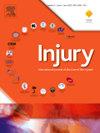Implementation and validation of a novel clinical bedside tool (Time-Up and Flex) in rehabilitation for geriatric hip fracture patients post hip fracture surgery
IF 2.2
3区 医学
Q3 CRITICAL CARE MEDICINE
Injury-International Journal of the Care of the Injured
Pub Date : 2025-03-25
DOI:10.1016/j.injury.2025.112282
引用次数: 0
Abstract
Objective
Fragility fractures in the elderly population is increasing due to the global aging population. Rehabilitation following hip fracture surgery plays a crucial role in restoring functional independence and quality of life. There are currently limited bedside rehabilitation tool for geriatric hip fracture patients. A novel tool (Time-Up and Flex [TUF]) was designed with the aim to allow patients perform bedside rehab exercises, provide objective feedback and enhance recovery.
Design
A single centre, double-blinded, prospective validation study. A 3D printed TUF tool measures time taken to actively flex the operated hip to 30° on post-operative days [POD] 1, 7 and 14. The time is compared against subjective (Numerical Patient Reported Pain Scale [NPRS]) and objective outcomes (Tinetti Scale [TS], Functional Ambulation Category [FAC]). Assessors of the TUF score are blinded to the assessors of patient report outcome measures.
Results
Mean time for TUF were 12.7 s (seconds), 9.5 s and 6.7 s, NPRS were 7.3, 4.8, 3.2, TS were 9.8, 14.1, 18.6, FAC were 1.2, 2.0, 3.1 on POD1, 7 and 14 respectively. Coefficient of correlation for TUF time against NPRS was 0.729 (p < 0.05), TUF time against TS was -0.721 (p < 0.05), TUF time against FAC -0.688 (p < 0.05). A decrease in TUF time correlated to a statistically significant decrease in NPRS, increase in TS and FAC. The calculated Cohen's D and Cronbach Alpha for TUF tool supported its ability to produce consistent and valid results.
Conclusion
TUF tool is valid and correlates with patient's subjective and objective outcomes. It has a good predictor value for the patient's pain, mobility and future falls risk. TUF tool has potential to be incorporated into geriatric hip fracture rehabilitation pathway in the future.
求助全文
约1分钟内获得全文
求助全文
来源期刊
CiteScore
4.00
自引率
8.00%
发文量
699
审稿时长
96 days
期刊介绍:
Injury was founded in 1969 and is an international journal dealing with all aspects of trauma care and accident surgery. Our primary aim is to facilitate the exchange of ideas, techniques and information among all members of the trauma team.

 求助内容:
求助内容: 应助结果提醒方式:
应助结果提醒方式:


